CCNA 3 Chapter 7 Exam Answers
-
Refer to the exhibit. After the configuration shown is applied on router R1, the exhibited status message is displayed. Router R1 is unable to form a neighbor relationship with R2 on the serial 0/1/0 interface. What is the most likely cause of this problem?
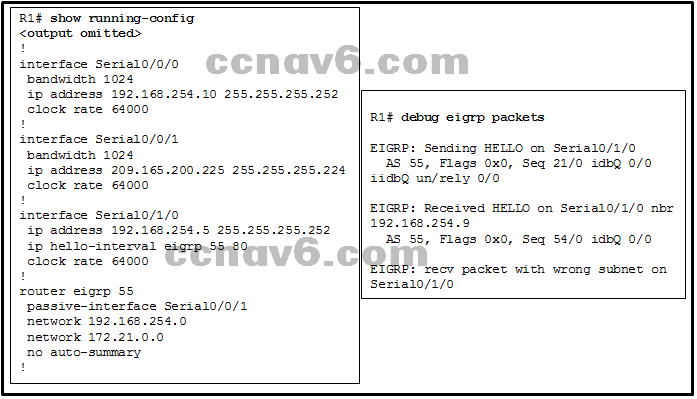
The network statement used for EIGRP 55 does not enable EIGRP on interface serial 0/1/0.
The hello interval has been altered on serial 0/1/0 and is preventing a neighbor relationship from forming.
The IPv4 address configured on the neighbor that is connected to R1 serial 0/1/0 is incorrect.*
The networks that are configured on serial 0/0/0 and serial 0/1/0 of router R1 are overlapping.
The passive-interface command should have been issued on serial 0/1/0.
-
By default, how many equal-cost routes to the same destination network will EIGRP install in the routing table?
2
4*
6
8
-
In which scenario will the use of EIGRP automatic summarization cause inconsistent routing in a network?
when the routers in an IPv4 network have mismatching EIGRP AS numbers
when the routers in an IPv4 network are connected to discontiguous networks with automatic summarization enabled*
when there is no adjacency that is established between neighboring routers
when there is no common subnet that exists between neighboring routers
-
What is the purpose of a Null0 route in the routing table?
to prevent routing loops*
to redistribute external routes into EIGRP
to act as a gateway of last resort
to prevent the router from sending EIGRP packets
-
Refer to the exhibit. Routers R1 and R2 are directly connected via their serial interfaces and are both running the EIGRP routing protocol. R1 and R2 can ping the directly connected serial interface of their neighbor, but they cannot form an EIGRP neighbor adjacency. What action should be taken to solve this problem?
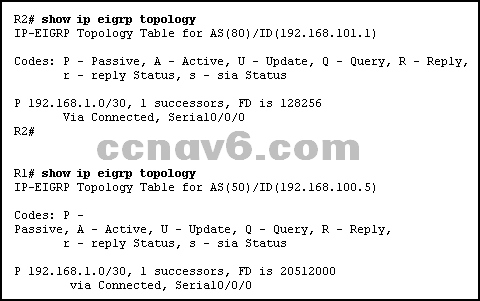
Configure EIGRP to send periodic updates.
Enable the serial interfaces of both routers.
Configure the same hello interval between the routers.
Configure both routers with the same EIGRP autonomous system number.*
-
Fill in the blank. Do not use abbreviations.
The _____________ command causes an EIGRP router to stop sending hello packets through an interface.
Correct Answer: passive-interface* -
Open the PT Activity. Perform the tasks in the activity instructions and then answer the question. R1 and R2 could not establish an EIGRP adjacency. What is the problem?
EIGRP is down on R2.
R1 Fa0/0 link local address is wrong.
EIGRP is down on R1.*
R1 Fa0/0 is not configured to send hello packets.
R1 Fa0/0 and R2 Fa0/0 are on different networks.
-
Refer to the exhibit. All networks are active in the same EIGRP routing domain. When the auto-summary command is issued on R3, which two summary networks will be calculated on R3? (Choose two.)
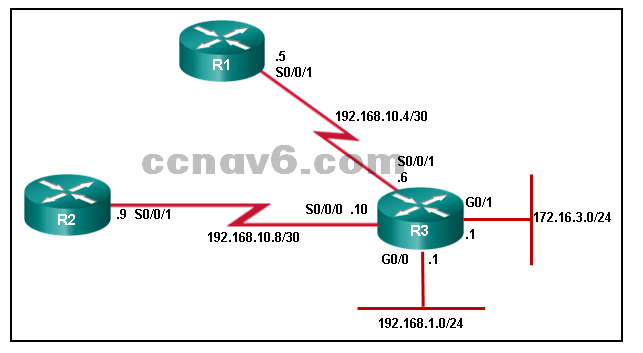
172.16.0.0/16*
172.16.3.0/24
192.168.1.0/30
192.168.10.0/30
192.168.10.0/24*
-
Which three statements are advantages of using automatic summarization?
(Choose three.)
It maximizes the number of routes in the routing table.
It decreases the number of entries in the routing table.*
It reduces the frequency of routing updates.*
It ensures that traffic for multiple subnets uses one path through the internetwork.*
It improves reachability in discontiguous networks.
It increases the size of routing updates.
-
Refer to the exhibit. Which two conclusions can be drawn from the exhibited configuration? (Choose two.)

The configuration supports unequal-cost load balancing.*
The configuration supports equal-cost load balancing.
Any EIGRP-learned route with a metric less than 3 times the successor metric will be installed in the local routing table.*
Any EIGRP-learned route with a metric equal to 3 times the successor metric will be installed in the local routing table.
The network statements require subnet masks to prevent autosummarization.
-
What is the administrative distance of externally learned EIGRP routes?
170*
120
110
90
-
Which routing protocol supports unequal-cost load balancing on Cisco routers?
OSPF
IS-IS
RIPv2
EIGRP*
-
Refer to the exhibit. Which two routes will be advertised to the router ISP if autosummarization is disabled? (Choose two.)
10.1.2.0/24*
10.1.0.0/16
10.1.4.0/28
10.1.4.0/30*
10.1.4.0/24
-
Which two steps must be taken in order to send a default route to other EIGRP routers? (Choose two.)
Configure a loopback address.
Configure a default route.*
Configure a router ID.
Ensure automatic summarization is disabled.
Redistribute the default route.*
-
Refer to the exhibit. Remote users are experiencing connectivity problems when attempting to reach hosts in the 172.21.100.0 /24 network. Using the output in the exhibit, what is the most likely cause of the connectivity problem?
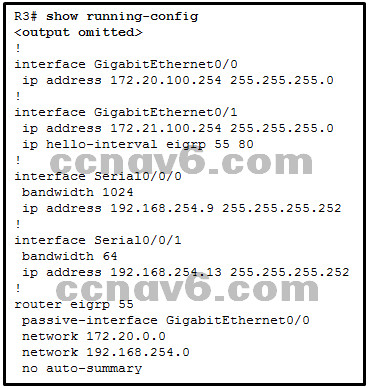
The hello timer has been modified on interface GigabitEthernet 0/1 of R3 and not on the neighbor, causing a neighbor
adjacency not to form.The GigabitEthernet interfaces are not limiting the flow of EIGRP message information and are being flooded with EIGRP traffic.
The passive-interface command is preventing neighbor relationships on interface GigabitEthernet 0/0.
The GigabitEthernet 0/1 interface is not participating in the EIGRP process.*
-
Refer to the exhibit. An administrator wants EIGRP on Router1 to load balance traffic to network 2001:db8:11:10::/64 across two interfaces. Currently traffic is using only interface GigabitEthernet0/1. A second route, not in the routing table, is available with a metric of 264000. What value is needed in the variance command to make EIGRP put the second route into the routing table?
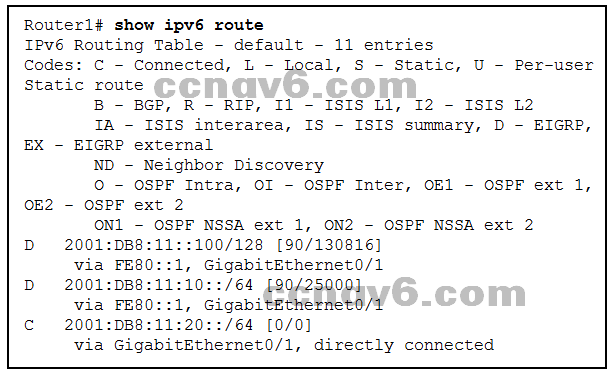
4
10
1
11*
-
Refer to the exhibit. Considering that R2, R3, and R4 are correctly configured, why did R1 not establish an adjacency with R2, R3, and R4?
because the Fa0/0 interface of R1 is declared as passive for EIGRP*
because there is no network command for the network 192.168.1.0/24 on R1
because the IPv4 address on Fa0/0 interface of R1 is incorrect
because the automatic summarization is enabled on R1
-
When a Cisco router is configured with fast-switching, how are packets distributed over equal-cost paths?
on a per-packet basis
on a per-interface basis
on a per-path-load basis
on a per-destination basis*
-
What is the default maximum amount of bandwidth that can be used for exchanging EIGRP messages on an EIGRP-configured interface?
50%*
10%
100%
75%
-
Fill in the blank. Do not use abbreviations.
The command to propagate the default route from the router Border to the rest of the EIGRP domain is Border(config-router)# _________
Correct Answer: redistribute static* -
Refer to the exhibit. Which statement is supported by the output?
A default route is being learned through an external process.*
The route to 192.168.1.1 represents the configuration of a loopback interface.
A static default route has been manually configured on this router.
Summarization of routes has been manually configured.
-
Which command can be issued on a router to verify that automatic summarization is enabled?
show ip protocols*
show ip eigrp neighbors
show ip eigrp interfaces
show ip interface brief
-
Assuming that EIGRP is enabled on both routers and automatic summarization is enabled, what must be configured to ensure that R1 will be able to reach the 2.2.2.0/24 network?

Use the command ip address-summary to ensure that R1 recognizes the 2.2.2.0 network.
Use the command no auto-summary to disable automatic summarization.*
EIGRP does not support VLSM and therefore cannot be used with discontiguous networks.
EIGRP supports VLSM and will automatically recognize the 2.2.2.0 network.
-
Two routers, R1 and R2, share a 64 kb/s link. An administrator wants to limit the bandwidth used by EIGRP between these two routers to 48 kb/s. Which command is used on both routers to configure the new bandwidth setting?
ip bandwidth-percent eigrp 64 48
ip bandwidth-percent eigrp 75 100
ip bandwidth-percent eigrp 100 75*
ip bandwidth-percent eigrp 100 48
ip bandwidth-percent eigrp 100 64
-
Refer to the exhibit. Router R3 is receiving multiple routes through the EIGRP routing protocol. Which statement is true about the implementation of summarization in this network?
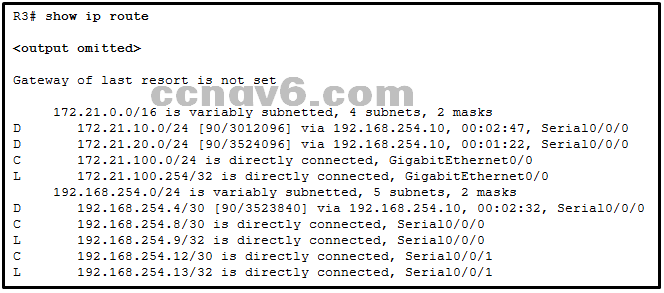
Automatic summarization has been enabled only for the 172.21.100.0/24 network.
Automatic summarization is disabled on R3.*
Automatic summarization is enabled on neighboring routers.
Automatic summarization is disabled on a per-interface basis.
